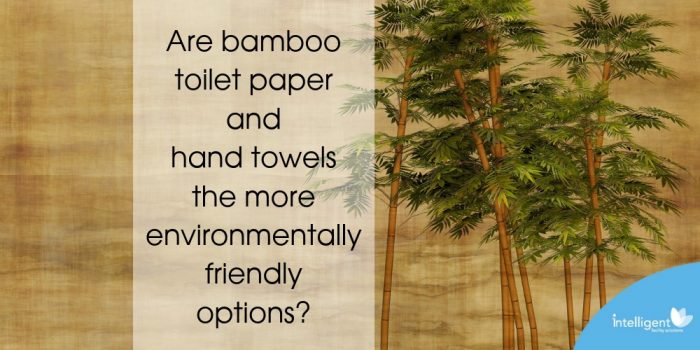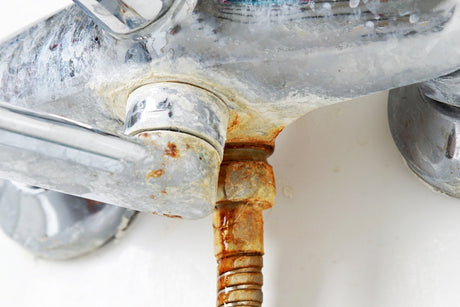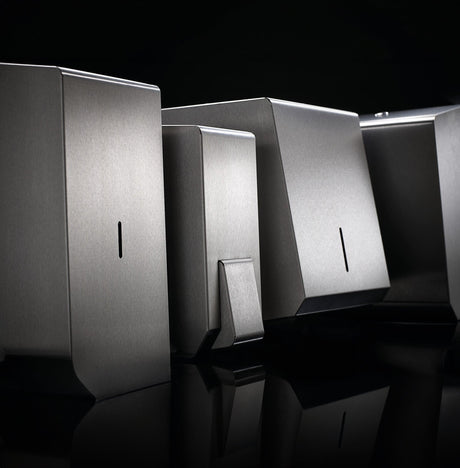
There is still a misperception amongst many that the toilet rolls and paper towels we use at home and in public restrooms are environmentally friendly. They come from sustainable forests and are biodegradable right?
Well, not really. The reality across the world is that we are consuming faster than we produce and the process of turning a tree from ‘a sustainable forest’ into a toilet roll or hand towel is far from sustainable.
Do you know about Bamboo Bobbi , our new bamboo toilet paper? Be sure to read about it, and the science behind why it’s a great alternative to your regular loo roll!
We all need to be doing our bit to combat climate change. We’ve all heard that paper production is bad for the environment and a contributor to global warming. But toilet paper in the bathroom, for its obvious role, is one thing we could do with keeping, couldn’t we?
If you are looking for a more sustainable and environmentally friendly paper to use in the washroom then this blog may answer a few questions you might have. It’s just a fundamental comparison at the moment but should give you enough answers for further debate.
By comparing standard paper and bamboo paper from growth to production and delivery to consumer, you will see that if paper really is your preferred option, there is possibly a much more sustainable and eco-friendly way of sourcing it.
Standard paper facts
The production of standard paper products including hand towels and toilet rolls in particular have a far-reaching environmental impact. This is well covered elsewhere but here is a quick 11-point summary of the environmental impact, broken down into stages:
Growing
1. Trees need to be grown and they don’t grow fast enough to supply the demand, so to increase the speed of this process, fertilisers and chemicals need to be used. It can take trees up to 100 years to grow and 90% of paper products come from natural, ancient forests. (Source: see video below)
2. A commercial woodland is not the same as a natural woodland where whole eco-systems evolve. It is reported that less than 20% of commercial forests produce all the wood we use for paper products (Source: see video below). We need more trees to absorb carbon and we need them to mature and become habitats. Too many natural woodlands are being cut down to meet demand and this is only going to get worse with a growing population.
Cutting down not harvesting
3. The felling of trees involves the use of heavy machinery and therefore fuel and emissions. The type of forest felled depends on the amount of emissions with commercial forests producing lower emissions due to easier operational conditions.
4. Lots of water is consumed in the process of production. See why we need to conserve water .
5. Trees do not re-grow, they have to be replanted each time they are felled or no more trees.
6. Trees need to be transported to a processing facility to create the pulp ready for turning into paper towels, a contributor to carbon production. The transportation aspect in all types of forest operations have reported the highest levels of emissions in studies produced.
7. The pulp needs to be transported again to be finished and then again to a warehouse and finally to a third or possibly 4 th warehouse. This often involves overseas travel of varying distances.
Additional chemicals
8. Paper towels aren’t pure tree. In order to effectively absorb water and look white, dioxins and other ingredients are added ( the manufacturers rarely disclose exactly what). Chlorine bleach is damaging to human skin, particularly young children and to the environment. To create a structure that doesn’t disintegrate synthetic fibres and resins must be added which make the towels slower to breakdown.
Packaging
9. The finished product is wrapped in single use plastic and often in cardboard boxes too.
Landfill
10. Paper towels are soiled waste so they end up in landfill. They are also not an easy material to recycle due to the synthetic fibres we mentioned previously as well as fibers that are too short to go through the recycling process again. In the process of breaking down it is releasing chemicals that have been added during producing and creating methane a harmful greenhouse gas contributing to climate change. Better Planet state that “almost 270,000 trees are sent to landfills every day, and roughly 10 percent of that total is attributable to toilet paper”.
Continuous cycle
11. And repeat; we use, we throw away, the truck collects, the product goes in the ground we get more.
The domestic market for reusable products is starting to grow which is great. Another positive is that electric hand dryers are curtailing this growth in away from home locations for the purpose of hand drying. But the change is not coming fast enough. Single use paper towel sales continue to rise.
We can eliminate paper towels almost entirely but toilet paper is harder. It is a big cultural shift for us all to move to bidets. Besides, that would lead to even more water usage, which we also know is a problem, so why not consider a bamboo-based toilet tissue?
We are currently conducting research with MBA students from Sheffield Hallam University into the sustainability of bamboo based toilet tissue. If we look at points 1-11 described above, we have been able to make the following observations:
Bamboo paper facts
Growing
1. Bamboo is named in the Guinness book of records as the fastest growing plant and although it produces strong natural fibres it can be used to create durable tissue and towels. It is technically a grass so regrows as soon as you cut it. It requires no chemicals to harvest it and far less water. It reaches maturity within 7 years when planted and can be harvested every year after this. So it’s a massive environmental winner at this stage.
2. The fast growth rates mean that once properly organised, it is more commercially viable to harvest and replace in a smaller area, so there is no need to destroy ecosystems. It can be treated like a farm crop without the need for fertilisation or heavy watering.
Cutting down and harvesting
3. The FSC certified Bamboo used in Bamboo Bobbi toilet roll is gathered and harvested by hand, no mechanical equipment is used at this stage.
4. Water requirements for the growth of bamboo are far lower (Source: see video above)
5. Bamboo re-grows without replanting. If you have ever tried to remove a bamboo tree from your garden you will vouch for this.
6. Transportation is required for bamboo as well as wood, this is where bamboo currently falls down a little as there aren’t as many commercially harvested bamboo plantations as there are forests. Adoption of the product would help to fuel more and more commercial plantations and prevent the raw material having to travel so far.
7. Transportation to further locations is unavoidable with a physical and disposable product, so both paper and bamboo are comparable.
Additional chemicals
8. Bamboo requires no additional chemicals to give it physical strength and softness. It is not bleached and is naturally anti-microbial. It is a purely natural product. (Source: see video above)
Packaging
9. The finished product can be wrapped in card but there is the issue of it getting wet during transportation. Both wood based and bamboo-based products have the same packaging requirements.
Landfill
10. Another key area where bamboo comes up trumps is how easily it returns to earth. As it remains in its natural state, it is not releasing toxins or chemicals just decomposing as dead bamboo would.
Continuous cycle
11. Of course, whether it’s bamboo or not, it remains a consumable product so the associated carbon footprint of replenishment remains. It is however less harmful than existing solutions.
We need to do far more research into this area before quantifying the exact impact. However, the recent 2020 report by Steven Shelley, which you can read below, collated information regarding the environmental impact of bamboo paper toilet tissue vs virgin and recycled toilet tissue. Table 1 below takes into account two complications, one is that some research papers present data per roll, rather than per sheet, so exact numbers are hard to define. So, we have to make assumptions regarding the number of sheets per roll, which is not standard, but to asses we have taken 200 sheets as the norm for comparison.
Also, as with any of these types of calculations, there is no single meaningful figure but rather a range. This is presented in table 1.
| Product name | Emission per sheet (gCO2e) |
| Bamboo Bobbi toilet paper | 0.66 |
| Cheeky Panda bamboo toilet paper towel | 0.69 |
| Recycled toilet tissue | 0.88 – 2.32 |
| Virgin source toilet tissue | 1.44 – 2.0 |
Table 1: Emissions per sheet of toilet tissue
It is however clear from comparing the impact at different stages that bamboo offers an exciting alternative.
Summary of the research conducted by Sheffield Hallam University MBA students on bamboo paper towels and standard paper towels
| Bamboo Paper Towel | Ordinary Paper Towel |
| Bamboo is mostly grown in tropical climate. It is fastest growing plant with less water and least pesticides. It grows 10-15 feet tall then it is cut down and dried which is sent out for chipping and pulping. | Ordinary paper is made from hardwood or soft word tress like spruce, spine, timber etc. They take several years to grow. The Wood is cut down bark is removed and sent out for chipping and pulping. |
| It has higher cellulose and long fibres which can make strong paper without using any chemicals. | Softwood has more fibres than hardwood so they combined with chemical additives to form strong paper |
| It easily gets broken in water and decomposed in soil. Therefore, its grave is soil causing no global warming or soil erosion. | Because they are mixed with chemicals it doesn’t get dissolved in water. Hence, they are sent to landfill. |
| Benefits: It is stronger, softer and cooler, it cuts down deforestation, safer to use than recycled tissues, biodegradable. | Benefits: Cheap and affordable, quick and easy to use. |
| Accreditation: ISO, FSC, BRC Global Standards, Cradle to grave reporting. An official website to apply for accreditation as per business needs ( https://www.ukas.com/the-route-to-accreditation / ). | Same as bamboo paper towel. |
| Import Commodity code: 4705000000VAT standard rate 20.00%Export Commodity code: 47050000 | Import Commodity code: 4818201000VAT standard rate 20.00%Export Commodity code: 48182010 |
| Major market players in UK, Europe and Australian markets: Who gives a crap, The Cheeky panda, Green Cane paper, Caboo. | Market players in UK and Europe are: Plenty, Tesco, Nicky, Regine, Sainsbury’s, Thirst Pockets |
| Distributors: This global sourcing company sends un-label products ( https://treefreesourcing.com/ ) Suppliers: Amazon online, Boots, Holland & Barrett, Morrisons, Tesco. | Suppliers: Tesco, Sinsbury’s, Aldi, Lidl, CO-OP, |
New Report May 2020
“A comparative environmental assessment of the use of bamboo in toilet tissue manufacturing”
The full report produced by Shelley (2020) usning the brand Bamboo Bobbi for analysis can be viewed by clicking here.
The purpose:
- To assess the comparative advantages of using bamboo as a raw material in the production of toilet tissue
- To assess the current claims of the benefits of bamboo in paper making
- To test the hypothesis that toilet paper produced from bamboo, even though shipped to the UK from China, has relative environmental benefits compared with tissue made from the more conventional practice of Scandinavian forest logging
Conclusions:
“The results show that that the scenario examined o ff ers the lowest full scope emissions between the products compared, especially if carbon sequestration credits are included. The hypothesis is thus considered proven: that toilet paper produced from bamboo, even though shipped to the UK from China, has relative environmental benefits compared with tissue made from the more conventional practice of Scandinavian forest logging. The environmental value of well managed bamboo plantations has been established.” Shelley (2020)
Main points in this blog article
- Bamboo is always available with fast growing rates which don’t require additional additives to speed up the process.
- Natural forests, containing eco-systems, are constantly being cut down as commercial woodland can’t cope with the demand.
- Eco-systems do not need to be destroyed as commercial farming of bamboo is more easily possible The jury is still out on the amount of energy used to cut down and harvest bamboo compared to standard paper.
- Less water is wasted in the cultivating of bamboo than standard paper.
- Bamboo starts to regrow as soon as it is cut down, making it one of the most sustainable natural products on earth.
- There are still transportation, machinery to cut and processing issues to evaluate for environmental effects of both paper products so this needs further consideration. Although as updated by Shelley (2020) report, bamboo paper products appear to win here.
- Bamboo is naturally strong, soft and white so no need to use chemicals to achieve this.
- Bamboo is biodegradable, returning to the soil and improving it without impact on global warming, keeping it out of methane producing landfills.
- Bamboo products still need to be packaged, which needs further consideration on the environmental impact.
- Bamboo seems, in the initial stages, to be a more eco-friendly source than standard methods for use as toilet paper.
We’ve also reviewed and compared the leading brands of bamboo toilet roll , saving you the work and hassle!
New for 2020 – Introducing our Bamboo Bobbi range , which includes bamboo toilet paper . Made from 100% sustainable, hand-cut bamboo it has a low environmental impact with minimal transportation and additional packaging. No extra wrapping. No fancy box. It’s not even white. Just 100% tree free, 100% sustainable bamboo toilet paper.
Our bamboo is hand cut and has a short journey of only 5 miles to our processing plant. We have worked hard to find what we believe to be the least environmentally impactful toilet paper you can buy.





